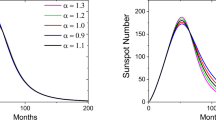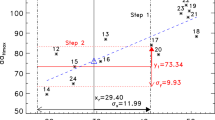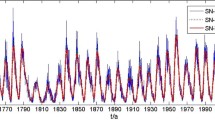Abstract
A similar-cycle method is applied in predicting the shape of Solar Cycle 25, through a more scientific definition to select similar cycles. Using the current solar minimum \(R_{\mathrm{min}}(25)\) as a reference, the six most similar cycles to Solar Cycle 25 are found to be Cycles 24, 15, 12, 14, 17, and 10 (in that order). The monthly values of sunspot-number series for the whole of Cycle 25 are predicted by weighted averaging the corresponding ones in the six similar cycles. As a result, Solar Cycle 25 is predicted to peak around October 2024 with an amplitude of about \(R_{\mathrm{m}}=137.8\pm 31.3\) and to end around September 2030. As a by-product, there might be a secondary peak eight months earlier. The similar-cycle method considers only the solar cycles with similar parameters rather than all ones as for regression methods. It has an advantage that it does not depend so much on the accuracy of the observation.







Similar content being viewed by others
References
Babcock, H.W.: 1961, The topology of the Sun’s magnetic field and the 22-year cycle. Astrophys. J. 133, 572. DOI.
Brown, G.M., Williams, W.R.: 1969, Some properties of the day-to-day variability of Sq(H). Planet. Space Sci. 17, 455. DOI.
Cameron, R., Schüssler, M.: 2008, A robust correlation between growth rate and amplitude of solar cycles: consequences for prediction methods. Astrophys. J. 685, 1291. DOI.
Choudhuri, A.R., Chatterjee, P., Jiang, J.: 2007, Predicting solar cycle 24 with a solar dynamo model. Phys. Rev. Lett. 98, 131103. DOI.
Clette, F., Cliver, E., Lefèvre, L., Svalgaard, L., Vaquero, J., Leibacher, J.: 2016, Preface to topical issue: recalibration of the sunspot number. Solar Phys. 291, 2479. DOI.
Dikpati, M., de Toma, G., Gilman, P.A.: 2006, Predicting the strength of solar cycle 24 using a flux-transport dynamo-based tool. Geophys. Res. Lett. 33, L05102. DOI.
Du, Z.L.: 2011a, The relationship between prediction accuracy and correlation coefficient. Solar Phys. 270, 407. DOI.
Du, Z.L.: 2011b, The shape of solar cycle described by a modified Gaussian function. Solar Phys. 273, 231. DOI.
Du, Z.L.: 2020a, The solar cycle: predicting the peak of solar cycle 25. Astrophys. Space Sci. 365, 104. DOI.
Du, Z.L.: 2020b, Predicting the amplitude of solar cycle 25 using the value 39 months before the solar minimum. Solar. Phys., accepted.
Du, Z.L., Li, R., Wang, H.N.: 2009, The predictive power of Ohl’s precursor method. Astron. J. 138, 1998. DOI.
Du, Z.L., Wang, H.N.: 2010, Does a low solar cycle minimum hint at a weak upcoming cycle? Res. Astron. Astrophys. 10, 950. DOI.
Du, Z.L., Wang, H.N.: 2011, The prediction method of similar cycles. Res. Astron. Astrophys. 11, 1482. DOI.
Du, Z.L., Wang, H.N.: 2012, Predicting the solar maximum with the rising rate. Sci. China Ser. G, Phys. Mech. Astron. 55, 365. DOI.
Gleissberg, W.: 1971, The probable behaviour of sunspot cycle 21. Solar Phys. 21, 240. DOI.
Han, Y.B., Wang, J.L.: 1999, Predicting monthly sunspot numbers of solar cycle 23 by the method of “similar cycles”. Chin. Astron. Astrophys. 23, 139. DOI.
Han, Y.B., Yin, Z.Q.: 2019, A decline phase modeling for the prediction of solar cycle 25. Solar Phys. 294, 107. DOI.
Hathaway, D.H.: 2015, The solar cycle. Liv. Rev. Solar Phys. 12, 4. DOI.
Hathaway, D.H., Wilson, R.M., Reichmann, E.J.: 1994, The shape of the sunspot cycle. Solar Phys. 151, 177. DOI.
Hathaway, D.H., Wilson, R.M., Reichmann, E.J.: 2002, Group sunspot numbers: sunspot cycle characteristics. Solar Phys. 211, 357. DOI.
Kane, R.P.: 2007, A preliminary estimate of the size of the coming solar cycle 24, based on Ohl’s precursor method. Solar Phys. 243, 205. DOI.
Labonville, F., Charbonneau, P., Lemerle, A.: 2019, A dynamo-based forecast of solar cycle 25. Solar Phys. 294, 82. DOI.
Leighton, R.B.: 1969, A magneto-kinematic model of the solar cycle. Astrophys. J. 156, 1. DOI.
Miao, J., Wang, J.L., Liu, S.Q., Gong, J.C.: 2008, Prediction of the beginning of solar activity cycle 24 by the similar cycle method. Chin. Astron. Astrophys. 32, 260. DOI.
Nordemann, D.J.R., Trivedi, N.B.: 1992, Sunspot number time series – exponential fitting and periodicites. Solar Phys. 142, 411. DOI.
Ohl, A.I., Ohl, G.I.: 1979, A new method of very long-term prediction of solar activity. In: Solar-Terrest. Predictions Proc. 2, 258. NASA/MSFC, ADS.
Pesnell, W.D.: 2008, Predictions of solar cycle 24. Solar Phys. 252, 209. DOI.
Pesnell, W.D., Schatten, K.H.: 2018, An early prediction of the amplitude of solar cycle 25. Solar Phys. 293, 112. DOI.
Ramesh, K.B., Lakshmi, N.B.: 2012, The amplitude of sunspot minimum as a favorable precursor for the prediction of the amplitude of the next solar maximum and the limit of the Waldmeier effect. Solar Phys. 276, 395. DOI.
Schatten, K.H.: 2005, Fair space weather for solar cycle 24. Geophys. Res. Lett. 32, L21106. DOI.
Schatten, K.H., Scherrer, P.H., Svalgaard, L., Wilcox, J.M.: 1978, Using dynamo theory to predict the sunspot number during Solar Cycle 21. Geophys. Res. Lett. 5, 411. DOI.
Stewart, J.Q., Panofsky, H.A.A.: 1938, The mathematical characteristics of sunspot variations. Astrophys. J. 88, 385. DOI.
Svalgaard, L., Cliver, E.W., Kamide, Y.: 2005, Sunspot cycle 24: smallest cycle in 100 years? Geophys. Res. Lett. 32, L01104. DOI.
Thompson, R.J.: 1988, The rise of solar cycle number 22. Solar Phys. 117, 279. DOI.
Thompson, R.J.: 1993, A technique for predicting the amplitude of the solar cycle. Solar Phys. 148, 383. DOI.
Volobuev, D.M.: 2009, The shape of the sunspot cycle: a one-parameter fit. Solar Phys. 258, 319. DOI.
Wang, J.L., Han, Y.B.: 1997, Forecasts of smoothed monthly mean sunspot numbers and non-smoothed monthly mean sunspot number for solar cycle 23. In: Astrophys. Rep. 1(Suppl), 76. ADS.
Wang, J.L., Gong, J.C., Liu, S.Q., Le, G.M., Han, Y.B., Sun, J.L.: 2002, Verification of a similar cycle prediction for the ascending and peak phases of solar cycle 23. Chin. J. Astron. Astrophys. 2, 396. DOI.
Wang, J.L., Zong, W.G., Le, G.M., Zhao, H.J., Tang, Y.T., Zhang, Y.: 2009, Predicting the start and maximum amplitude of solar cycle 24 using similar phases and a cycle grouping. Res. Astron. Astrophys. 9, 133. DOI.
Wilson, R.M., Hathaway, D.H., Reichmann, E.J.: 1998, An estimate for the size of cycle 23 based on near minimum conditions. J. Geophys. Res. 103, 6595. DOI.
Yoshida, A.: 2014, Difference between even- and odd-numbered cycles in the predictability of solar activity and prediction of the amplitude of cycle 25. Ann. Geophys. 32, 1035. DOI.
Yoshida, A., Yamagishi, H.: 2010, Predicting amplitude of solar cycle 24 based on a new precursor method. Ann. Geophys. 28, 417. DOI.
Acknowledgements
We are grateful to the anonymous reviewer for valuable suggestions, which improved the quality of this manuscript. This work is supported by the National Science Foundation of China (NSFC) through grants 11973058 and 11603040.
Author information
Authors and Affiliations
Corresponding author
Ethics declarations
Disclosure of Potential Conflicts of Interest
The author declares that they have no conflicts of interest.
Additional information
Publisher’s Note
Springer Nature remains neutral with regard to jurisdictional claims in published maps and institutional affiliations.
Rights and permissions
About this article
Cite this article
Du, Z. Predicting the Shape of Solar Cycle 25 Using a Similar-Cycle Method. Sol Phys 295, 134 (2020). https://doi.org/10.1007/s11207-020-01701-4
Received:
Accepted:
Published:
DOI: https://doi.org/10.1007/s11207-020-01701-4




